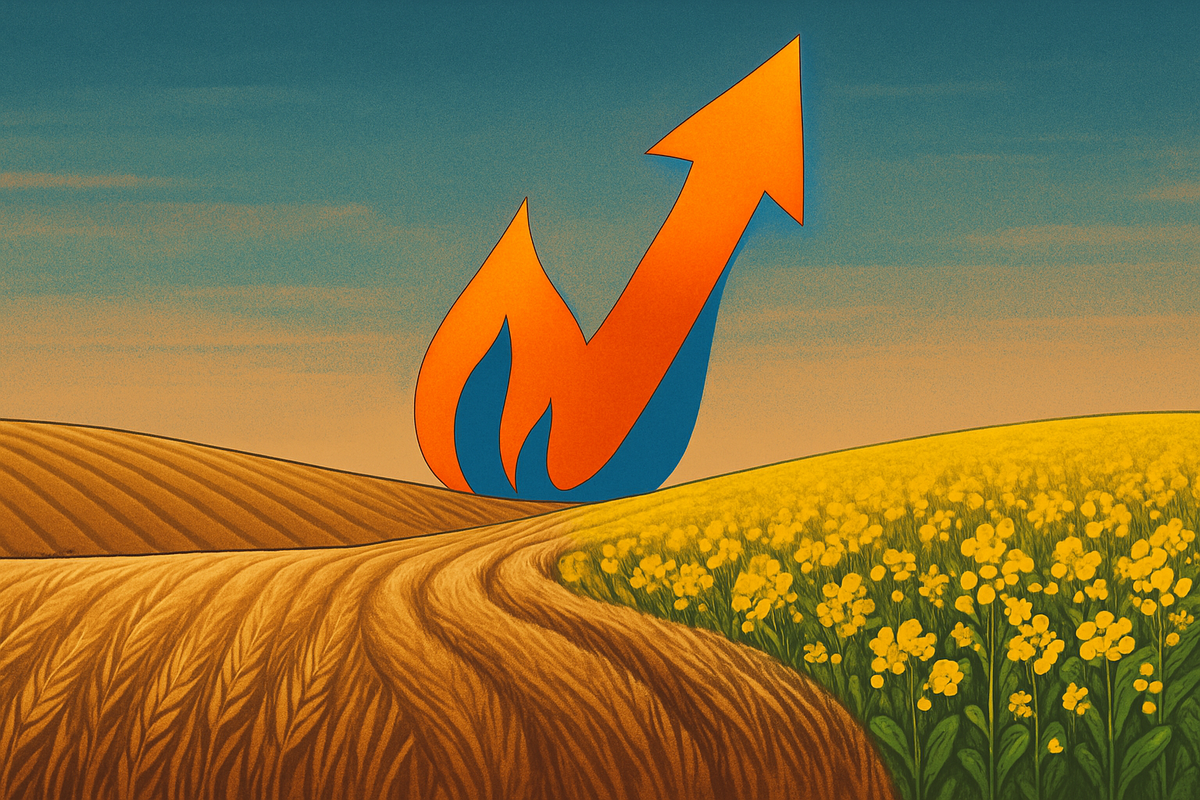Financial News
Commodities Conclude November 19th with Mixed Signals: Natural Gas Rallies Amid Cold Snap, Grains See Minor Adjustments

November 19, 2025 – Commodity markets closed today with a mosaic of movements, as natural gas staged a notable rally driven by impending cold weather, while agricultural staples like canola and wheat experienced minor, yet distinct, fluctuations. The day's trading highlighted the intricate dance between weather patterns, global supply-demand dynamics, and speculative sentiment, offering a glimpse into the underlying pressures shaping the financial landscape. These subtle shifts underscore the volatility inherent in commodity trading and the diverse factors influencing vital global resources.
The immediate implications suggest a strengthening energy market as winter approaches, potentially impacting heating costs and industrial consumption. Meanwhile, the mixed performance in grains reflects an ongoing tug-of-war between robust global supply forecasts and persistent demand uncertainties, leaving market participants to weigh the balance of short-term tactical plays against longer-term strategic positioning.
A Closer Look at the Day's Commodity Movements
November 19, 2025, proved to be a day of nuanced adjustments across key commodity sectors. Canola futures generally trended lower, with prices falling to approximately 649.64 CAD/T, marking a 1.03% decrease from the previous day. Another report indicated a closing price of 654.00 CAD/T, down 0.29% for the day. The January canola contract (ICE: RSF2026) was specifically noted at 649.80 CAD/tonne, down 6.60 at midday. This decline was largely attributed to profit-taking activities, coupled with weakness in the Chicago soy complex and drops in both MATIF rapeseed and Malaysian palm oil markets. Despite this daily correction, the January contract managed to hold above its 20- and 50-day moving averages, suggesting underlying support, especially given a 5.56% rise over the past month. Market sentiment for canola, despite the daily dip, remained "mixed to up," bolstered by higher demand and tighter spot availability, though a persistent lack of significant export business to China remained a bearish undercurrent. Canadian farmers' reluctance to sell also prompted commercial buyers to raise prices, providing a floor to the market.
Wheat futures presented a more fragmented picture, closing with mixed results across various contracts. Chicago SRW (Soft Red Winter) futures (CBOT: WZ2026) saw slight gains, increasing fractionally by 2 ¼ cents. Conversely, Kansas City HRW (Hard Red Winter) futures (KCBT: KWZ2026) experienced declines of 1 to 3 cents. Leading the gains were Minneapolis spring wheat futures (MGEX: MWZ2026), which rose by 6 to 9 cents in nearby contracts. Trading Economics reported a general fall in wheat to 535.71 USd/Bu, down 1.97% from the previous day, highlighting the varied performance across different benchmarks. The market sentiment for wheat was largely mixed, influenced by speculative buying on expectations of new Chinese demand, which was counterbalanced by USDA data indicating larger-than-anticipated increases in US and world ending stocks. Hopes of increased demand from China following a recent trade agreement offered some support, alongside technical buying and short covering by funds. Globally, the International Grains Council projected a record 2025-26 crop of 819 million tonnes, which dampened the urgency for forward buying.
The most dynamic movement of the day was observed in natural gas futures (NYMEX: NGZ2026), which experienced a significant rally. The front-month Nymex Natural Gas contract for December delivery gained 17.90 cents, or 4.10%, to settle at $4.5500 per million British thermal units. This marked its largest single-day dollar and percentage gain since November 11th, 2025. The rally was primarily fueled by forecasts of colder weather ahead, which are expected to substantially increase heating demand across key regions. Traders also anticipated the season's first significant storage withdrawal of approximately 12 Bcf, a pivotal shift in seasonal fundamentals from earlier injection trends. While US dry gas production remained robust, demand was accelerating, supported by rising lower-48 gas usage and strong LNG feedgas volumes. Goldman Sachs analysts projected that natural gas price spread compression is ahead as LNG capacity surges.
Companies Navigate Volatile Commodity Waters: Energy Producers Surge, Agricultural Players Face Mixed Fortunes
The nuanced movements in canola and wheat, coupled with a significant rally in natural gas, are poised to create a distinct landscape of winners and losers among public companies. Businesses across the agricultural and energy sectors will experience direct and indirect impacts, shaping their revenue streams, operational costs, and ultimately, their profitability.
The slight downturn in canola futures presents a mixed bag. For agricultural firms with crushing capacity and biofuel producers, a generally bullish sentiment in canola over the longer term, despite today's dip, could still be beneficial. Major Canadian agribusinesses like Richardson International Limited and Viterra Inc., with substantial canola crushing operations, stand to gain from increased demand for processed canola products. Similarly, diversified agribusiness giants such as Archer-Daniels-Midland Company (NYSE: ADM) and Bunge Global SA (NYSE: BG), which have robust oilseed crushing divisions, could see positive contributions to their revenues from higher crush margins if the underlying canola price trends upward. Companies actively expanding canola acreage, such as Três Tentos Agroindustrial SA (B3: TTEN3), are also well-positioned for increased revenues. Conversely, food manufacturers that heavily rely on canola oil as a key ingredient might face higher input costs, potentially squeezing their profit margins if these costs cannot be effectively passed on to consumers. Companies dealing with Canadian canola products could also face headwinds from existing trade disputes, such as China's tariffs, impacting profitability and market access.
For wheat, where global supply has recently tempered prices, the impact leans more towards the benefit of consumers and traders. Grain traders and food manufacturers that consume wheat as a raw material are likely to be among the beneficiaries. Companies like Archer-Daniels-Midland Company (NYSE: ADM) and Bunge Global SA (NYSE: BG), which are deeply involved in the origination, processing, and transportation of agricultural commodities, could see improved margins from lower raw material costs for their milling and food product divisions. MGP Ingredients Inc. (NASDAQ: MGPI), known for its wheat-based distillery and food products, could also see benefits from reduced input expenses. The Andersons, Inc. (NASDAQ: ANDE), with its trade segment focused on commodity merchandising and grain elevator operations, could capitalize on price differentials and increased trading activity in a volatile market. On the losing side, wheat producers and farming companies with significant exposure to wheat production, such as Adecoagro (NYSE: AGRO), are likely to face financial pressures due to potentially reduced revenues and tighter profit margins from a bearish pricing environment. Indirectly, a slowdown in farm incomes could lead farmers to defer large capital expenditures, negatively impacting sales for agricultural machinery manufacturers like Deere & Company (NYSE: DE) and AGCO Corporation (NYSE: AGCO).
The most significant shifts are anticipated in the natural gas sector, following its substantial rally. Natural gas Exploration & Production (E&P) companies are clear winners. Producers with significant natural gas assets will likely see a surge in revenues and profitability. This includes major players such as EQT Corporation (NYSE: EQT), the largest natural gas producer in the U.S., and Cheniere Energy (NYSE: LNG), a leading liquefied natural gas (LNG) producer and exporter. Other prominent companies like ExxonMobil (NYSE: XOM), Chevron (NYSE: CVX), ConocoPhillips (NYSE: COP), Southwestern Energy Co. (NYSE: SWN), and Diamondback Energy Inc. (NASDAQ: FANG) will also benefit significantly. Newer entities formed from mergers, such as Expand Energy Corp. (NASDAQ: EXE), would also be substantial beneficiaries. While their revenue models are often fee-based and less directly exposed to price volatility, midstream companies like Kinder Morgan (NYSE: KMI) and ONEOK Inc. (NYSE: OKE), which operate natural gas pipelines and storage facilities, may also see increased volumes and potentially higher transportation fees. Conversely, utilities that rely heavily on natural gas for power generation, such as Duke Energy (NYSE: DUK), will face significantly higher fuel costs. These costs are often passed on to consumers, but regulatory lag or an inability to fully recover costs can impact utility profitability. Chemical manufacturers, for whom natural gas is a dominant feedstock and energy source, will also face dramatically increased production costs. This could affect major chemical producers like Dow Chemical (NYSE: DOW) and LyondellBasell (NYSE: LYB). Critically, fertilizer producers like CF Industries Holdings, Inc. (NYSE: CF) and Nutrien Ltd. (NTR) will be severely impacted, as natural gas accounts for a significant portion of the production cost for nitrogenous fertilizers.
The ripple effects of these commodity price movements are far-reaching, influencing not only the direct players but also the broader economic landscape. Companies with diversified portfolios or robust hedging strategies are better positioned to navigate these volatile markets, underscoring the importance of risk management in an ever-changing commodity environment.
Wider Implications: A Glimpse into Energy Transition Volatility and Agricultural Resilience
The commodity market's performance on November 19th, 2025, while exhibiting minor fluctuations in grains, paints a broader picture of current industry trends and potential future trajectories, particularly in the energy sector. The significant rally in natural gas, contrasted with the more subdued movements in canola and wheat, underscores the complex interplay of global factors, from climate patterns to geopolitical strategies.
The substantial surge in natural gas prices is a potent reminder of the inherent volatility within the ongoing global energy transition. Often touted as a "bridge fuel" between fossil fuels and renewable energy, natural gas's price sensitivity to weather forecasts and supply-demand balances highlights the challenges of decarbonization. This rally fits into a broader trend of increased reliance on LNG as a global energy source, particularly evident since the 2021-2022 European energy crisis. That period starkly demonstrated how geopolitical events and supply disruptions can weaponize energy, leading to unprecedented price spikes and significant ripple effects on industrial production, inflation, and government policy worldwide. The current rally could signal renewed concerns about energy independence and the need for diversification, further accelerating investments in renewable energy alternatives as countries seek to reduce their exposure to volatile fossil fuel markets. For industrial partners and competitors, particularly in the chemical and fertilizer sectors, sustained high natural gas prices will translate directly into elevated operational costs, potentially impacting competitiveness and forcing strategic pivots towards greater energy efficiency or alternative feedstocks.
In the agricultural sector, the minor fluctuations in canola and wheat prices, even amidst a significant energy market shift, reflect an ongoing dialogue about food security, inflation, and the resilience of global food systems. While not as dramatic as the natural gas rally, these movements are influenced by broader trends such as climate change impacts on crop yields, the adoption of precision agriculture technologies, and evolving global trade dynamics. Historically, periods like the 2007-2008 food price crisis have shown how interconnected energy costs, adverse weather, and demand shifts can lead to significant food inflation. While the current situation is less severe, the underlying principles remain relevant. Minor price changes, even if absorbed in the short term, contribute to the cumulative cost pressures on food processors and ultimately, consumers. Regulatory discussions might focus on the adequacy of strategic grain reserves or existing farm support programs in light of fluctuating market conditions and input costs, especially as higher natural gas prices will eventually translate to increased fertilizer costs for farmers, impacting future planting decisions and crop economics.
The ripple effects extend beyond direct market participants. Higher natural gas prices will inevitably translate to increased electricity costs for businesses and households, potentially dampening economic activity and exacerbating inflationary pressures. This could prompt governments to consider policy interventions, such as consumer protection measures, subsidies, or even closer scrutiny of LNG export volumes to prioritize domestic supply. For the renewable energy sector, a sustained period of high natural gas prices could provide a competitive advantage, making solar, wind, and other clean energy solutions more economically attractive and potentially accelerating their deployment. The day's trading, therefore, serves as a microcosm of the larger, interconnected challenges and opportunities facing the global economy as it navigates energy transitions, climate impacts, and evolving geopolitical landscapes.
What Comes Next: Navigating Inflationary Headwinds and Strategic Shifts
The commodity market's movements on November 19th, 2025, particularly the sharp ascent of natural gas prices, set the stage for a period of dynamic shifts and strategic adaptations across the energy and agricultural sectors. Market participants, from farmers to industrial giants, will need to navigate a landscape shaped by evolving supply-demand fundamentals, geopolitical realities, and the persistent drive towards sustainability.
In the short term (next 3-6 months), the most immediate and pronounced impact will be felt from the natural gas rally. Given that natural gas is a critical feedstock for nitrogen-based fertilizers, accounting for a significant portion of their production costs, higher natural gas prices will inevitably translate to increased fertilizer expenses for farmers. This will exert upward pressure on agricultural commodity prices, including canola and wheat, even if their direct daily fluctuations were minor. Farmers, facing elevated costs for inputs like fertilizers, fuel, and transportation, may pass these costs onto consumers, contributing to broader food price inflation. There's a tangible risk that some farmers might reduce fertilizer application to mitigate costs, potentially impacting crop yields and future supply. For the natural gas market itself, the rally indicates robust demand, potentially tighter supply, or strong geopolitical influences, suggesting continued price strength as the Northern Hemisphere enters peak winter heating season. This will likely incentivize increased production, though significant supply responses typically require lead times for infrastructure and drilling.
Looking at the long term (beyond 6 months), the market's trajectory will depend on how effectively participants adapt and how underlying fundamentals evolve. In the agricultural sector, sustained high natural gas prices could lead to permanently elevated agricultural commodity prices, reflecting a higher cost base for production. This could spur accelerated adoption of precision agriculture technologies to optimize fertilizer use, and encourage exploration of alternative soil nutrient management strategies or shifts to crops requiring less synthetic nitrogen. Businesses along the agricultural supply chain may also seek to diversify sourcing and strengthen logistics to build resilience against future energy-related cost shocks and geopolitical disruptions. For the natural gas market, sustained high prices could incentivize significant investment in new production and Liquefied Natural Gas (LNG) liquefaction and regasification capacity, potentially leading to an oversupply scenario in the mid-to-long term (e.g., beyond 2027-2028) that could eventually ease prices. However, high prices could also accelerate the transition to renewable energy sources for power generation and industrial use, particularly in regions with strong decarbonization policies, gradually reducing long-term demand for natural gas in certain segments.
These dynamics necessitate strategic pivots and adaptations. For agricultural producers, enhanced risk management through hedging strategies (futures, options) will be crucial to lock in input costs or selling prices. Investing in energy-efficient farming practices and exploring renewable energy sources for farm operations will become increasingly vital. Industrial and commercial consumers of natural gas will need to accelerate investments in energy efficiency, explore fuel switching where feasible, and strategically secure long-term supply contracts. For traders and investors, dynamic portfolio adjustments, increased volatility trading, and a sharpened focus on fundamental analysis of supply/demand, weather patterns, and geopolitical developments will be paramount.
Market opportunities will emerge in the natural gas sector for producers and LNG exporters, as well as for companies involved in energy infrastructure development. In agriculture, businesses developing and supplying precision agriculture technologies, organic fertilizers, or other sustainable farming inputs stand to gain. Conversely, challenges include heightened food security concerns and inflation, significant pressure on agricultural producer margins, and increased market volatility across interconnected commodity markets. Potential scenarios range from an immediate inflationary spiral impacting food prices, to a mid-term reduction in agricultural output due to high input costs. In the long term, we could see an accelerated energy transition driven by high natural gas prices, or a supply response leading to a market correction. Geopolitical instability remains a variable that could amplify any of these outcomes, further disrupting supply chains and increasing overall commodity market volatility.
MarketMinute Wrap-Up: Navigating a Period of Elevated Volatility and Strategic Redefinition
The closing commodity prices on November 19th, 2025, particularly the significant rally in natural gas and the nuanced movements in canola and wheat, underscore a period of heightened volatility and strategic redefinition for global markets. The key takeaway is the direct and potent link between energy costs and agricultural production, foreshadowing inflationary pressures that will ripple throughout the economy.
Moving forward, the market will be characterized by a complex interplay of factors. The immediate future points towards sustained high energy costs, which will inevitably elevate the cost of food production. This scenario demands resilience and adaptability from all stakeholders. Agricultural producers will need to embrace advanced risk management techniques and cost-optimization strategies to maintain viability. Energy-intensive industries will be compelled to accelerate their transition to more efficient practices and diversified energy sources.
The lasting impact of these events could be a dual acceleration: a quicker shift towards sustainable and energy-efficient practices in agriculture, and a more aggressive push towards renewable energy sources in the broader energy sector. While the short-term outlook suggests inflationary headwinds and potential challenges to food security, these pressures also create fertile ground for innovation and strategic re-evaluation. Investors should watch closely for shifts in government policy regarding energy security, agricultural subsidies, and trade agreements, as these will play a crucial role in shaping market dynamics. Furthermore, monitoring weather patterns, global inventory levels, and geopolitical developments will be essential for anticipating future price movements and identifying emerging opportunities in this evolving commodity landscape.
This content is intended for informational purposes only and is not financial advice
More News
View More




Recent Quotes
View More
Quotes delayed at least 20 minutes.
By accessing this page, you agree to the Privacy Policy and Terms Of Service.



